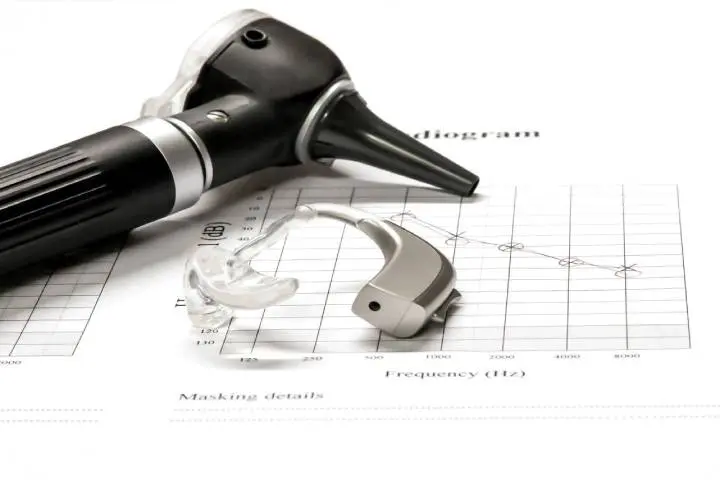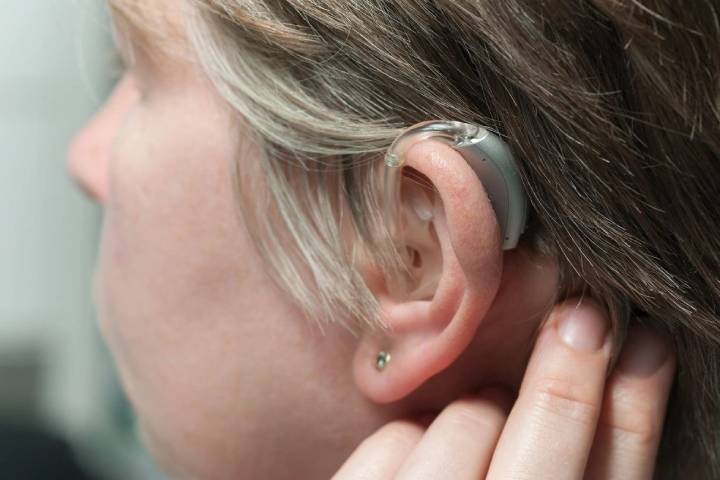
Hearing Loss – Signs, Symptoms & Treatment Options
Often, people may find it difficult to figure out that they are actually suffering from hearing loss. In most cases, hearing loss doesn’t occur suddenly and is a gradual process, with signs and symptoms appearing over time.
Hence, you need to be aware of the signs of hearing loss and seek timely treatment to improve your quality of life. Explore the page to learn more about HearWay Audiology hearing aids and treatment methods.
6 Signs of Hearing Loss
-
Difficulty following conversations – You may find it difficult to follow group conversations, especially when there is background noise
-
Phone conversations are unclear – You have difficulty following phone conversations even in quiet and less noisy places
-
You ask people to repeat themselves – People sound like they are mumbling or you ask them to repeat themselves way too often
-
Difficulty locating sounds – You can hear the sounds but have difficulty locating where they are coming from
-
Signs of tinnitus – You are constantly disturbed by ringing or buzzing sounds in your ears
-
Turning up the TV too loud – Your friends and family say you turn the television up too loud

Identifying Early Symptoms
It may be difficult to notice when your hearing begins to decline, since hearing loss is a gradual process. In fact, friends and family may notice it before you do. You need to have a sound understanding of the signs and symptoms to seek treatment and improve your hearing.
Book an appointment at HearWay Audiology for an in-depth hearing evaluation. I will identify your level of hearing loss and recommend the right treatment plan for you.
Improve Your Quality of Life
Hearing loss occurs gradually and can increase over time if left untreated. Recognizing the early symptoms can greatly improve your quality of life and save you from the unpleasant consequences, such as:
-
Missing out on conversations with friends, colleagues, and loved ones
-
Inability to hear and converse with freedom in social environments
-
Feelings of isolation or depression


Types of Hearing Loss
Hearing loss can be broadly classified into 3 types: sensorineural, conductive, and mixed. Sensorineural hearing loss is the most common type of hearing loss resulting from the normal aging process and/or extensive exposure to loud sounds.
In order to understand the availability of treatment options, you need to be able to differentiate between sensorineural hearing loss and other types of hearing loss.
-
Sensorineural hearing loss – Damage to the inner ear or auditory nerve prevents proper transmission of sound waves to the brain.
-
Conductive hearing loss – This results from damage to the external and/or middle ear and is medically treatable in most cases.
-
Mixed hearing loss – This refers to cases where certain aspects of both sensorineural and conductive hearing loss are present.
Sensorineural Hearing Loss
Patients with sensorineural hearing loss may find sounds unclear or difficult to hear. Using hearing aids is a proven and effective method to treat this type of hearing loss.
Causes
Sensorineural hearing loss results from:
-
Normal aging process (presbycusis)
-
Extensive exposure to noise
-
Drugs and medications
Signs
-
Difficulty following conversations involving more than two people
-
Difficulty following a conversation when there’s background noise
-
Difficulty understanding phone conversations
-
Sounds seem unclear or people sound like they are mumbling
-
Difficulty hearing high-pitched sounds
-
Ringing or buzzing in the ears, called tinnitus
Conductive Hearing Loss
This type of hearing loss involves the obstruction of sound waves traveling from the external and middle ear to the inner ear.
Causes
Conductive hearing loss is typically caused by an obstruction in the ear canal due to the accumulation of ear wax (cerumen) or liquid. This blocks the path of the sound and prevents it from reaching the ear drum.
Signs
-
Speech and other sounds seem distant or muffled
-
Pain, pressure in, or discharge from the ear
-
A feeling of “fullness”
-
Decrease in the volume of the sounds (but the sounds are not distorted)
Treatment
The choice of treatment depends on the level of hearing loss and the amount or nature of the obstruction.
-
Ear wax removal
-
Medical treatment
-
Surgical treatment
Other Types of Hearing Loss
-
High or low-frequency: This indicates your inability to hear high or low-pitched sounds
-
Unilateral or bilateral: Indicates whether one (unilateral) or both (bilateral) ears are affected by hearing loss
-
Progressive or sudden: Indicates whether your hearing loss has taken place gradually or rapidly within a few days
-
Acquired or congenital: Indicates whether you had an in-born hearing inability or developed hearing loss at a later stage in life
Sudden Hearing Loss
In case of sudden hearing loss, you are recommended to seek immediate medical attention. You have a greater possibility of regaining your hearing partially or fully if such conditions are treated inside the first 72 hours. This type of hearing loss is characterized by:
-
Unexplained rapid loss of hearing
-
Loss of hearing all at once or over a couple of days
-
It is almost always experienced in one ear only
-
It can go away by itself, or be reversed by medical treatment
-
Vertigo
Tinnitus
Tinnitus is one of the first signs of hearing loss and is typically characterized by a ringing, buzzing, roaring, hissing, or whistling sound in the ear that is only audible to you. Most commonly, tinnitus is caused by damage to the tiny hair cells in the inner ear resulting from extensive noise exposure.
The buzzing sound that you hear is a result of your brain trying to compensate for the loss of hair cells. The reduced signals from the ear are misinterpreted by the brain, leading to a false perception of sound that only you can hear. About 15-20 percent of hearing loss patients are affected by tinnitus.

Levels of Hearing Loss
There are several categories of hearing loss depending on the severity level. Your hearing ability level is measured in decibels (dB) and denotes how loud the sounds need to be for you to hear them.
Normal Hearing (≤25 dB)
No perceived hearing loss symptoms.
Mild Hearing Loss (26-40 dB)
Soft speech is difficult to hear, especially in noisy environments.
Moderate Hearing Loss (41-60 dB)
People find it difficult to follow conversations in noisy environments or group settings.
Severe Hearing Loss (61-80 dB)
People have to speak loudly for you to hear them.
Profound Hearing Loss (≥81 dB)
Hearing becomes challenging in most environments.

Hearing Loss Treatment Options
With the advancement of technology, there are a wide variety of treatment options available for most types of hearing loss conditions. Hearing aids represent the most common treatment procedure for hearing loss.
A bone-anchored hearing aid (BAHA) or a cochlear implant (CI) may be recommended in some cases. In more complex situations, alternative medical solutions or surgery may be required to improve the quality of life.
Please remember that the quality of your outcome will depend on how quickly you seek medical assistance, regardless of the treatment option.
3 Steps to Improve Your Hearing
Choose HearWay Audiology Inc. for your hearing challenges and improve your hearing in just 3 simple steps:
1. Schedule your complimentary hearing assessment online or over the phone
2. Risk-free trial and experience first-hand
3. Change your life with high-quality hearing care and receive complimentary aftercare program benefits


Advanced Hearing Aids
The advancement of technology in the audiology domain has greatly impacted the designs of hearing aids. Hearing aids in today’s market is smaller than ever and far more technologically advanced. In fact, some of them are virtually invisible. Despite their size, these hearing aids are equipped with the best features to offer excellent sound quality even in difficult listening environments.
FAQs
Here are some frequently asked questions on the signs and symptoms of hearing loss:
What Is the First Sign of Hearing Loss?
One of the most common warning signs of hearing loss is difficulty following conversations (or understanding what others are saying). If you think you might have hearing loss, take our quick test to find out if you should get your hearing checked.
Is Tinnitus a Sign of Hearing Loss?
When to Seek Help for Hearing Loss?
A Detailed Explanation of the Human Hearing Mechanism
Here is a step-by-step description of how individuals hear—from the time sound waves reach the outer ear, via the middle and inner ear, and onto the brain as meaningful signals. These impulses help the brain organize and communicate with the outside world.
Step 1: Sound Waves Enter the Ear
The sound initially enters the outer ear, also referred to as the pinna or auricle. The pinna is the part of your ear that is visible, and its funnel-like design allows the filtration and amplification of sound waves as they enter the ear canal.
Sound waves then strike the eardrum, or tympanic membrane, which causes it to vibrate.
Step 2: Transmission Through the Middle Ear
The middle ear is located behind the eardrum. Sound waves are amplified in this section of the ear's anatomy before being transmitted to the inner ear.
The eardrum is connected to the ossicles, a chain of three tiny bones. These bones are set in motion when the eardrum vibrates in reaction to sound waves.
The malleus ("the hammer") is the bone that is directly related to the eardrum and is connected to the incus ("the anvil") at the opposite end. The stapes (the "stirrup" or "footplate") are linked to the incus. The nicknames for the ossicles are derived from their forms.
Step 3: Sounds Enter the Inner Ear (Cochlea)
The stapes create pressure waves in the fluid-filled cochlea, the snail-shaped inner ear that houses the organ of Corti, by pushing on the oval window. Vibrations are finally converted into electrical energy in the organ of Corti by cells known as hair cells (stereocilia).
The cochlea is lined by tiny hair cells that are stimulated by sounds of different frequencies. You are born with about 16,000 of these cells. These hair cells convert sound waves' vibrations into electrical impulses, which subsequently travel to the brain via a complicated network of nerve fibers.
Step 4: Interpretation of Signals by the Brain
After the sound is converted to electrical impulses in the cochlea, the signals travel to the auditory cortex and other portions of the brain that control consciousness and sensory experience via a complicated circuit of auditory nerve routes.
These are referred to as the auditory pathways that decode the sound waves and convert them into something meaningful for the brain to process.
Functionality & Limitations of Hearing Aids
Hearing aids can be life-changing for persons who suffer from hearing loss. Hearing aids not only improve your quality of hearing but also provide additional advantages, such as enhanced general health and quality of life, greater social involvement, and even a lower risk of falling.
However, any hearing expert will tell you that hearing aids aren't the same as eyeglasses. While your hearing will certainly improve, it won't be restored to its original state like putting on spectacles will.

Consequences of Untreated Hearing Loss
When left untreated, hearing loss worsens over time and affects more than just your ability to hear things clearly. It leads to a wide array of mental, emotional, and sociological problems that include:
Declining Mental Sharpness
Your mental sharpness may deteriorate if you have trouble hearing what's going on around you. This is due to a decrease in brain stimulation, which could impede the brain's ability to process sound and detect speech.
Increases Risks of Dementia
Even a mild instance of hearing loss increases your chances of developing dementia. The severity of the case determines the likelihood of cognitive decline.
Increases Possibility of Memory Loss
Do you have trouble recalling what you've just heard? When it's tough to hear what's being said in the first place, it can be challenging to comprehend and recall what's being said.
This is because the extra cognitive resources required to listen deplete memory and comprehension capabilities.
Feeling Left Out of Conversations
It becomes harder to follow regular conversations as your hearing deteriorates. To comprehend discussions, you may need to ask individuals to repeat themselves frequently. Conversely, you may need to sit closer to them, so you can read their lips or monitor their facial expressions.
You can even pretend to grasp what's being said by nodding. If you miss the punchline, jokes aren't as hilarious.
Hampers Social Life
When you have trouble hearing, it may be more difficult to keep in touch with your pals. In other situations, such as large gatherings or dinner parties, it may be more apparent.
As a result, you may retreat from social activities or decline invitations. According to studies, seniors with untreated hearing loss are 20-24 percent less likely to engage in social activities.
Increases Risks of Anxiety
You may find it challenging to comprehend and identify sounds as your hearing ability deteriorates. This could make you feel unsafe in your surroundings.
Increased Fatigue Levels
Communication can be exhausting when it's tough to hear. This is due to the fact that understanding necessitates a deeper dive into your cognitive reserves.
This can be especially draining at social gatherings, restaurants, or in crowds, where you may need to focus even harder to understand what others are saying.
Reduces Earning Potential
As per studies conducted by the Better Hearing Institute, untreated hearing problems might have a negative influence on your earning potential.
It can cost you up to $30,000 in lost wages each year and have a negative influence on your work performance. You risk missing important information in meetings if you don't hear clearly.
